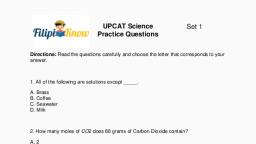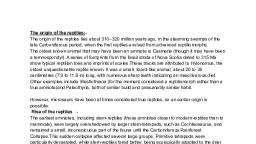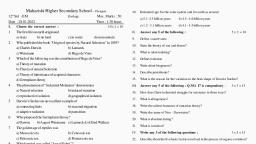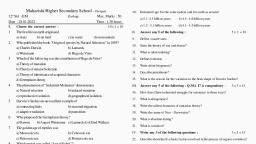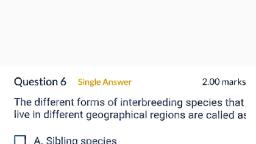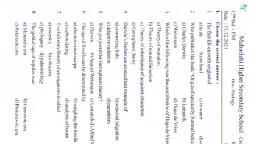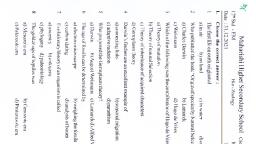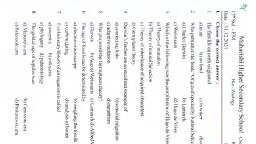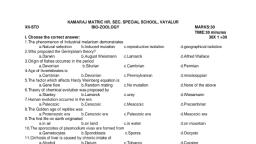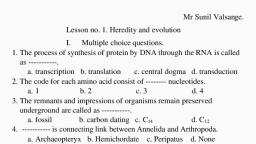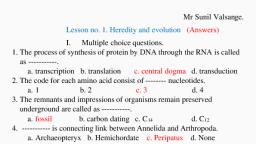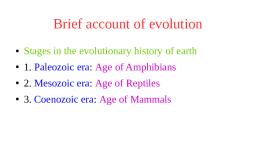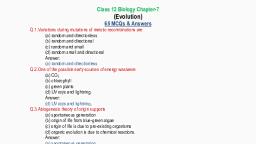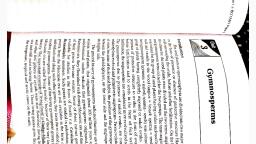Page 1 :
Genera1, , 2 Activity Sheet, MELC 3, History of Life on Earth, , 1
Page 2 :
REGION VI – WESTERN VISAYAS, General Biology 2 - Grade 11/12, Activity Sheet No. 3: History of Life on Earth, First Edition, 2021, Published in the Philippines, By the Department of Education, Region 6 – Western Visayas, Republic Act 8293, section 176 states that: No copyright shall subsist in any, work of the Government of the Philippines. However, prior approval of the, government agency or office wherein the work is created shall be necessary for, exploitation of such work for profit. Such agency or office may, among other things,, impose as a condition the payment of royalties., This Learning Activity Sheet is developed by DepEd Region 6 – Western, Visayas., ALL RIGHTS RESERVED. No part of this learning resource may be, reproduced or transmitted in any form or by any means electronic or mechanical, without written permission from the DepEd Regional Office 6 – Western Visayas., , 2
Page 3 :
3
Page 4 :
Introductory Message, Welcome to General Biology 2!, The Learning Activity Sheet is a product of the collaborative efforts of the Schools, Division of Aklan and DepEd Regional Office VI - Western Visayas through the Curriculum, and Learning Management Division (CLMD). This is developed to guide the learning, facilitators (teachers, parents and responsible adults) in helping the learners meet the, standards set by the K to 12 Basic Education Curriculum., The Learning Activity Sheet is self-directed instructional materials aimed to guide the, learners in accomplishing activities at their own pace and time using the contextualized, resources in the community. This will also assist the learners in acquiring the lifelong learning, skills, knowledge and attitudes for productivity and employment., , For learning facilitator:, The General Biology 2 Activity Sheet will help you facilitate the leaching-learning, activities specified in each Most Essential Learning Competency (MELC) with minimal or no, face-to-face encounter between you and learner. This will be made available to the learners, with the references/links to ease the independent learning., , For the learner:, The General Biology 2 Activity Sheet is developed to help you continue learning even, if you are not in school. This learning material provides you with meaningful and engaging, activities for independent learning. Being an active learner, carefully read and understand the, instructions then perform the activities and answer the assessments. This will be returned to, your facilitator on the agreed schedule., , 4
Page 5 :
Name of Learner:, School:, , Grade Level/Section:, Date:, , Teacher:, , History of Life on Earth, I., , Learning Competency with Code, Describe general features of the history of life on Earth, including generally, accepted dates and sequence of the geologic time scale and characteristics of major, groups of organisms present during these time periods STEM_BIO11/12-IIIc-g-8, II., , Background Information for Learners, One of the great mysteries in the Universe is the origin of creation. Biologists rely, primarily on dating the rocks in which fossils are contained and looking at the "molecular, clocks" in living organisms' DNA to do this. Based on the most accepted propositions,, life started at least 3.5 billion years ago, since that's the age of the world's oldest rocks, with fossil proof of life. These rocks are rare because the surface of our planet has been, reshaped by subsequent, geological cycles, sometimes, crushing, older, rocks, while, creating new ones., Scientists have broken the, Earth's 4.56-billion-year history, into units that represent unique, periods of time based on their, interpretations of the rock record., Taken together, the geologic time, scale is made up of these time, periods., Eons, represent, the, greatest expanses of time. Eons, are divided into eras. Each era is, subdivided into periods. Finally,, periods are divided into smaller, units called epochs. Each period, within an era is characterized by, somewhat, lesser, profound, changes in life forms as, compared with the changes that, occur during an era. The periods, of the Cenozoic era are divided, into still smaller units called, epochs, during which even lesser, profound changes in life forms, occur. During Precambrian time,, there were fewer life forms. These, life forms are more difficult to, identify and the rocks have been disturbed often., , 5
Page 6 :
The eon where life began was during the Phanerozoic eon.There are three eras, within the Phanerozoic eon: the Paleozoic, which means “ancient life,” the Mesozoic,, which means “middle life,” and the Cenozoic, which means “recent life.”, For ease in discussion and remembering, the eras will be the basis of division of, the history of life. The following are the four eras of the origin of life: Precambrian,, Paleozoic, Mesozoic and Cenozoic chronologically., Precambrian History, The Precambrian encompasses immense geological time, from Earth’s distant, beginnings 4.56 billion years ago until the start of the Cambrian period, over 4 billion, years later. Earth’s original atmosphere was made up of gases similar to those released, in volcanic eruptions today—water vapor, carbon dioxide, nitrogen, and several trace, gases, but no oxygen., The oldest fossils of single-celled organisms date from 3.5 billion years ago., Some single-celled organisms may be feeding on methane by this time. At 2 billion years, ago, Eukaryotic cells – cells with internal “organs” (known as organelles) – come into, being. One key organelle is the nucleus: the control center of the cell, in which the genes, are stored in the form of DNA. Eukaryotic cells evolved when one simple cell engulfed, another, and the two lived together, more or less amicably – an example of, “endosymbiosis”. The engulfed bacteria eventually become mitochondria, which provide, eukaryotic cells with energy. The last common ancestor of all eukaryotic cells had, mitochondria – and had also developed sexual reproduction., Later, primary plants evolved that used photosynthesis and released oxygen., Oxygen began to accumulate in the atmosphere about 2.5 billion years ago. The most, common Precambrian fossils are stromatolites. Stromatolites are distinctively layered, mounds or columns of calcium carbonate. They are not the remains of actual organisms, but are the material deposited by algae. Many of these ancient fossils are preserved in, chert—a hard dense chemical sedimentary rock., Early Paleozoic (Life Explodes), Following the long Precambrian, the most recent 540 million years of Earth’s, history are divided into three eras: Paleozoic, Mesozoic, and Cenozoic., Life in early Paleozoic time was restricted to the seas. Laurasia is the, continental mass that formed the northern portion of Pangaea, consisting of present-day, North America and Eurasia. By the end of the Paleozoic, all the continents had fused into, the supercontinent of Pangaea., Some 400 million years ago, plants that had adapted to survive at the water’s, edge began to move inland, becoming land plants. The amphibians rapidly diversified, because they had minimal competition from other land dwellers., The world’s climate became very seasonal, probably causing the dramatic, extinction of many species. The late Paleozoic extinction was the greatest of at least five, mass extinctions to occur over the past 500 million years., Mesozoic Era (Age of Reptiles), The gymnosperms quickly became the dominant plants of the Mesozoic era., Gymnosperms are seed-bearing plants that do not depend on free-standing water for, fertilization., , 6
Page 7 :
The development of the shelled egg characterized the animal life of this era., Unlike amphibians, reptiles have shell-covered eggs that can be laid on the land. The, elimination of a water-dwelling stage (like the tadpole stage in frogs) was an important, evolutionary step. With the perfection of the shelled egg, reptiles quickly became the, dominant land animals. At the end of the Mesozoic era, many reptile groups became, extinct., Cenozoic Era (Age of Mammals), The Cenozoic era is divided into two periods of very unequal duration, the, Tertiary period and the Quaternary period. Plate interactions during the Cenozoic era, caused many events of mountain building, volcanism, and earthquakes in the West., Mammals—animals that bear live young and maintain a steady body, temperature—replaced reptiles as the dominant land animals in the Cenozoic era., Adaptations like being warm blooded, developing insulating body hair, and having more, efficient heart and lungs allow mammals to lead more active lives than reptiles., Angiosperms—flowering plants with covered seeds—replaced gymnosperms as, the dominant land plants., Large mammals started to become extinct at the later part of the era. In North, America, the mastodon and mammoth, both huge relatives of the elephant, became, extinct. In addition, saber-toothed cats, giant beavers, large ground sloths, horses,, camels, giant bison, and others died out on the North American continent. The reason for, this recent wave of extinctions puzzles scientists., III., Activity Proper, A. Direction: Place the following data (dominating life form/description) in the, appropriate Era of Life., gymnosperms, angiosperms, dinosaurs, last universal common ancestor, homo sapiens, no oxygen, 4.5 Billion years ago first terrestrial life, first birds, bacteria, ocean life, first flowering plants, modern era, ice age, first fungi, breast feeding animal, Precambrian, 1., 2., 3., 4., , Paleozoic, 1., 2., 3., 4., , Mesozoic, 1., 2., 3., 4., , Cenozoic, 1., 2., 3., 4., , B. Multiple Choice: Read the questions carefully and encircle the letter of the, correct answer., 1. Evidence from rocks allows us to understand the, of life on Earth., a. Evolution, b. uniformity c. rotation, d. all of these, 2. The first forms of life on earth were, a. single-celled, b. multicellular c. photosynthetic, d. plants, 3. Simple, multicellular organisms like jellies and sponges evolved during, a. Precambrian, b. Paleozoic c. Mesozoic d. Cenozoic, 4. Earth has been around for about, years., a. 3.5 billion, b. 4.6 billion c. 5 million, d. 10, 5., of a species occurs when the environment changes and the, adaptive characteristics of a species are insufficient for its survival., a. mutation, b. adaptation c. evolution, d. extinction, , 7
Page 8 :
C. Once Upon a Time… You can do this individually or in a group of at most 3, members. Create a timetable of the History of Life on Earth. You may use, varying materials and any kinds of arts/craft like collage, painting, drawing,, etc. Present your output. Place on a separate sheet., RUBRICS (15 Points):, CATEGORY, 1, 3, 5, Craft, There is no, Level of complexity, Complexity in, difficulty in, in creation required, creation, creation, a little difficulty, characterized by, details, materials, used and skills, Model does not, Model slightly, Model clearly, Concept, exemplify the, exemplifies the, exemplifies the, History of life on, History of life on, History of life on, Earth, Earth, Earth, Display, Didn’t prepare, Piece is prepared, Piece is prepared, Readiness, piece for display, for display but will, for display either, at all., not remain stable, hanging, resting, on table or, securely attached, to a stable stand., Won’t fall off/fall, over., IV., Reflection, Complete the statements below., I understand, , I don’t understand, , I need more information about, , 8
Page 9 :
9






